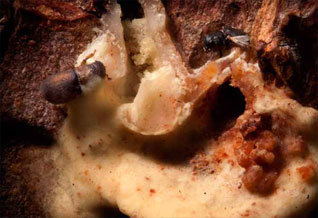
Dead Trees Don't Drink
How will mountain pine beetles— and attempts to control them— affect aquatic ecosystems?
TheScience
How are Colorado’s drinking water and the ecosystems in the watersheds that provide it, impacted by beetle kill and the chemicals meant to mitigate it?
the headwaters of many river basins critical for drinking water in Colorado, and working in the relatively pristine park eliminates some potentially confounding effects—septic systems, for example, which can add nutrients to a system.
For the pesticide work, van Drunick and her colleagues will collect water samples in the spring of 2010—the peak of the tree-spraying season—from areas immediately downstream of treated trees. The park has focused its limited spray campaign to less-toxic carbaryl, one type of carbamate, in high-priority areas, such as near campgrounds. Homeowners living in scattered private inholdings within the park may also be spraying trees, with potential consequences on aquatic ecosystems.
"Initially, we’ll look at areas likely to have the highest concentrations of pesticides," van Drunick said. If the samples show high levels of carbaryl or other pesticides, then she and her colleagues can plan further sampling.
"We certainly don’t expect to see enough carbaryl to flat-out kill fish," van Drunick said, "but we can monitor carbaryl to determine if concentrations are high enough to cause sublethal effects such as changes in respiration or swimming performance in fish, or changes in the composition of aquatic invertebrate communities, which could, in turn, affect fish."
McCutchan will measure a suite of nutrients in water samples collected from montane streams in the park during several times of year—including samples from the 2009 and 2010 "Water Blitz," a collaboration with Rocky Mountain National Park scientists interested in monitoring water quality in the park. The single-day Blitz, conducted with the help of dozens of Park Service employees and volunteers, generates a water quality "snapshot in time," McCutchan said.
"We hope that by putting together snapshots with more intensive time sampling, we can go beyond monitoring to analysis, and to understanding the system in a more complete way," he said. ![]()
Tiny beetles barely the size of a grain of rice have wreaked havoc on western forests in the United States and Canada during the last decade. An outbreak of mountain pine beetles, Dendroctonus ponderosae, has turned whole mountainsides of once-green forests brown, brittle, and dead.
CIRES ecologists James McCutchan (Associate Director of CIRES’ Center for Limnology) and Suzanne van Drunick (CIRES’ Associate Director for Science) are trying to understand how those changes—and people’s attempts to control the beetle outbreak with chemicals—are affecting regional water quality and ecosystems.
Their work is funded by the Western Water Assessment, a joint project of CIRES and NOAA.
"Vegetation in a watershed affects the quality and quantity of water," McCutchan said. "If the pine beetles kill the trees, then one link in a complex system has been taken out. We’d like to understand what that means."
Growing forests intercept some of the precipitation and nutrients that fall within a watershed. Tree and other plant roots pull up water that percolates through soil, and remove phosphorous, nitrogen, and other nutrients. As trees die, more nitrogen or carbon may flow downstream, for example, affecting communities of aquatic algae, plants, insects, and even fish. If more phosphorous flows downhill, McCutchan said, it could affect drinking water quality downstream. Some mountain reservoirs—such as Dillon Reservoir—are required to keep phosphorous below certain levels, and often come close to surpassing them.
When human activities add chemical insecticides to the mix—carbamates or pyrethroids are the key ones used to fight pine beetles—there may be further effects on aquatic ecosystems, van Drunick said.
McCutchan and van Drunick will focus their research in Rocky Mountain National Park, for two key reasons: the park is home to


